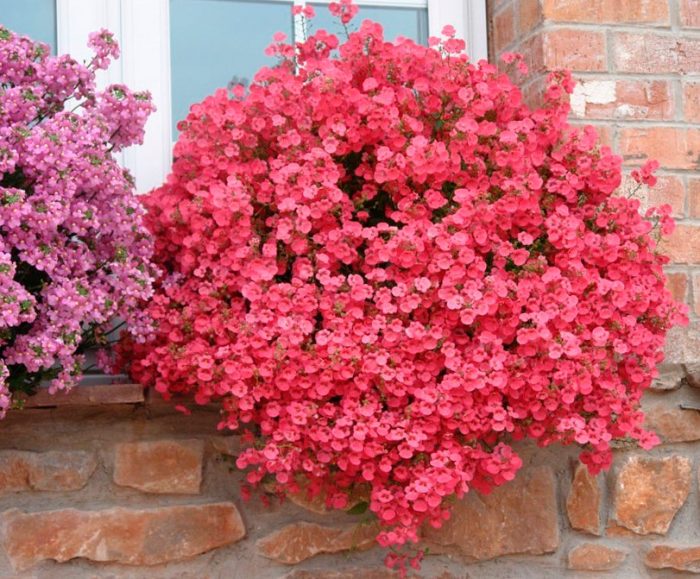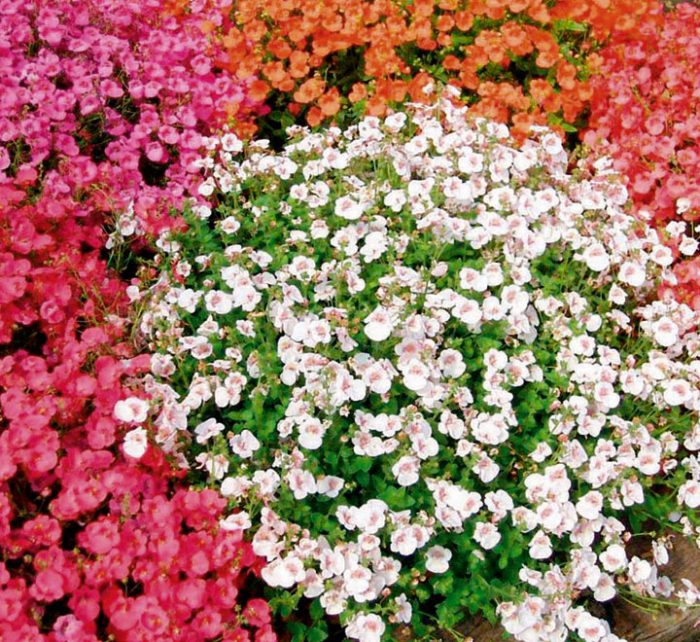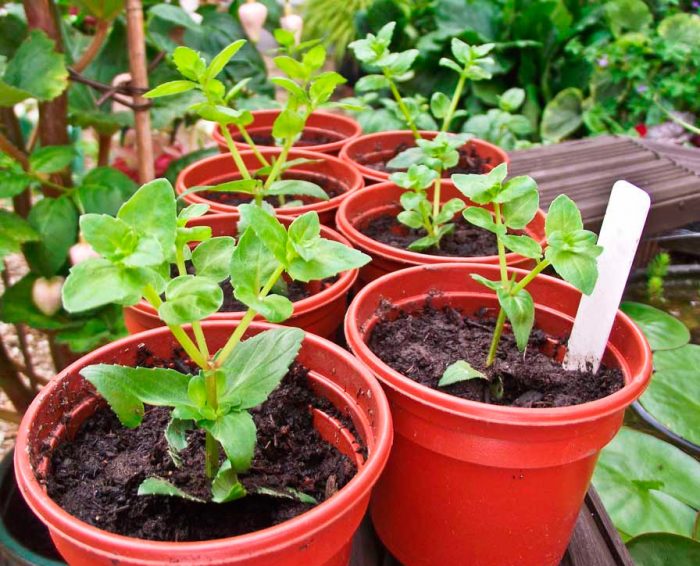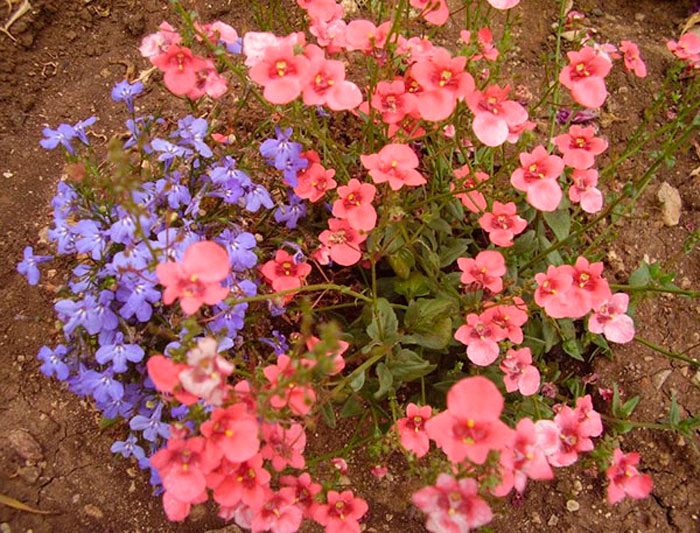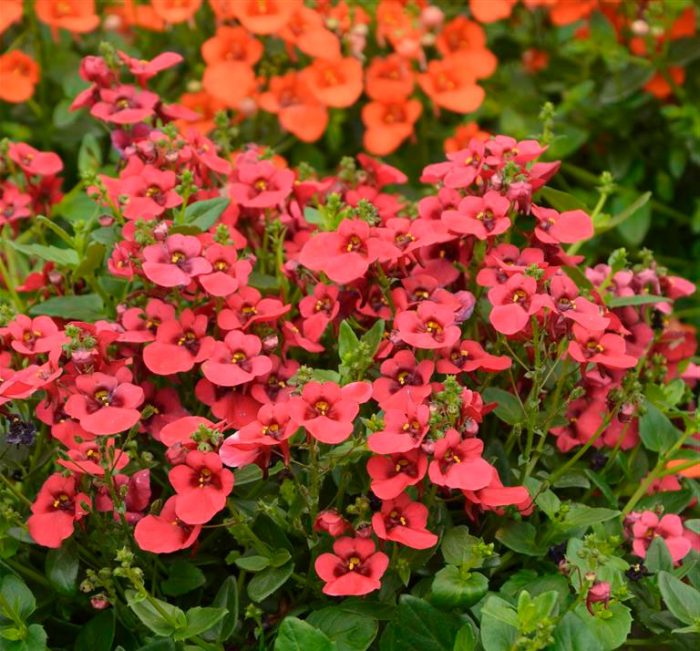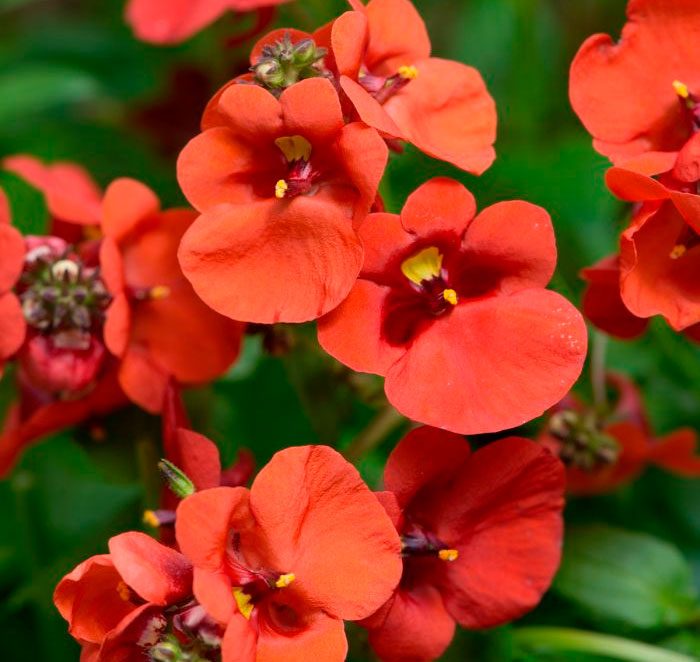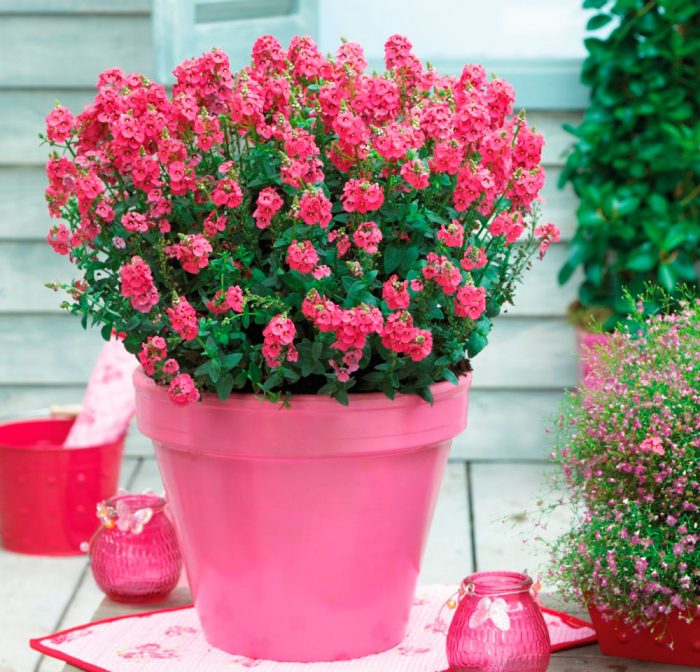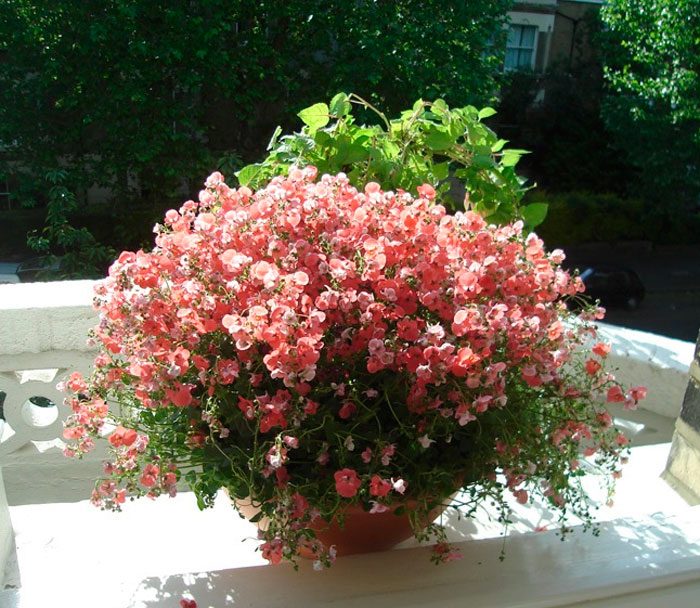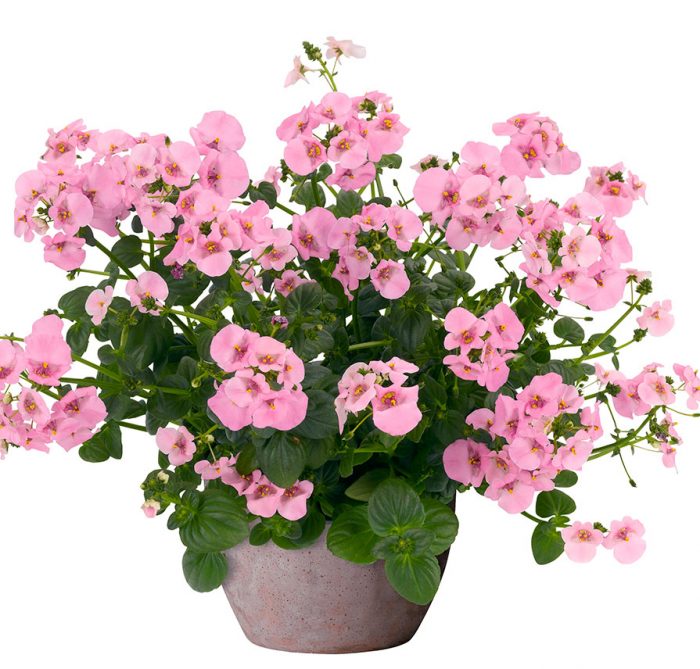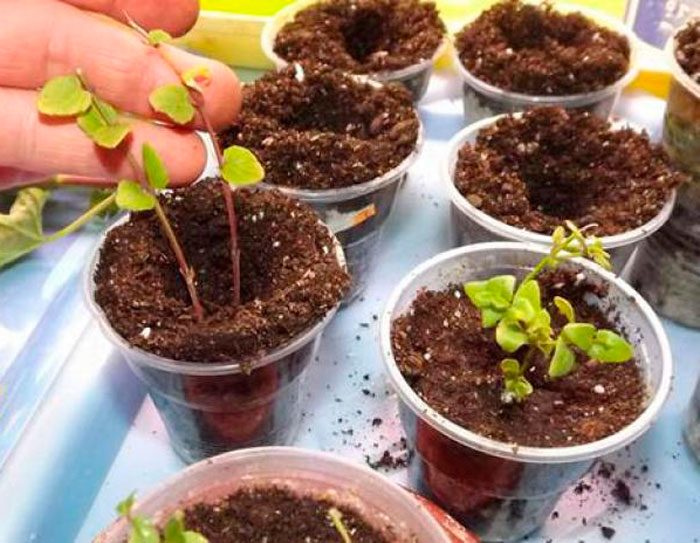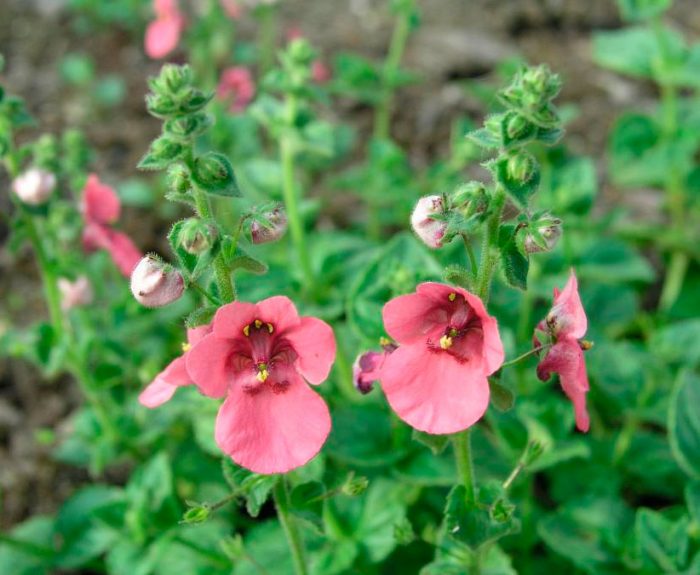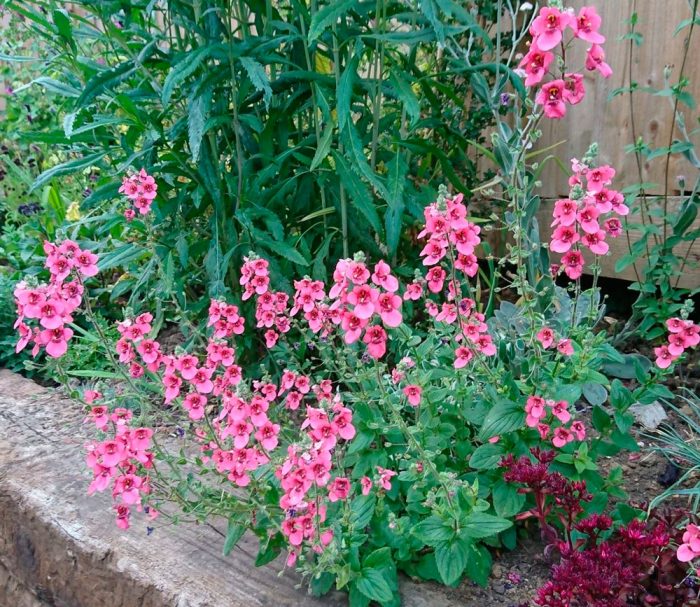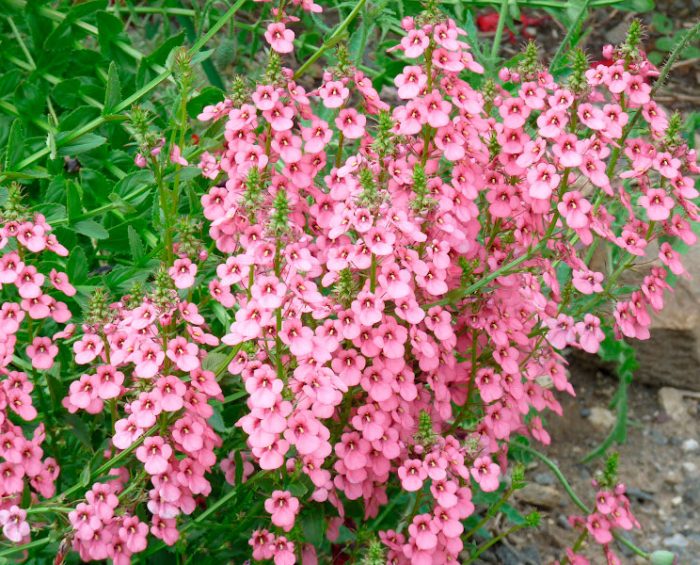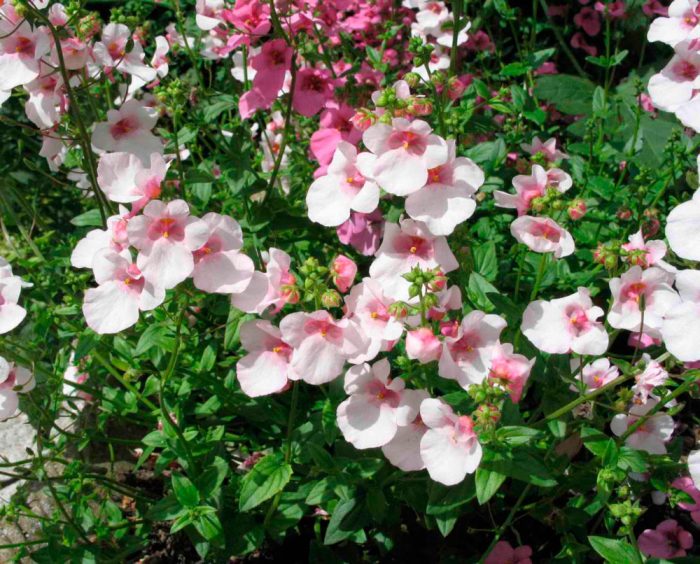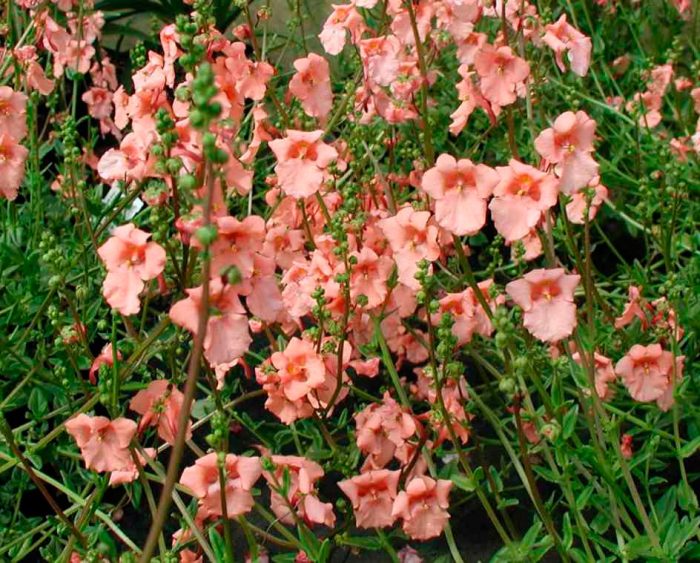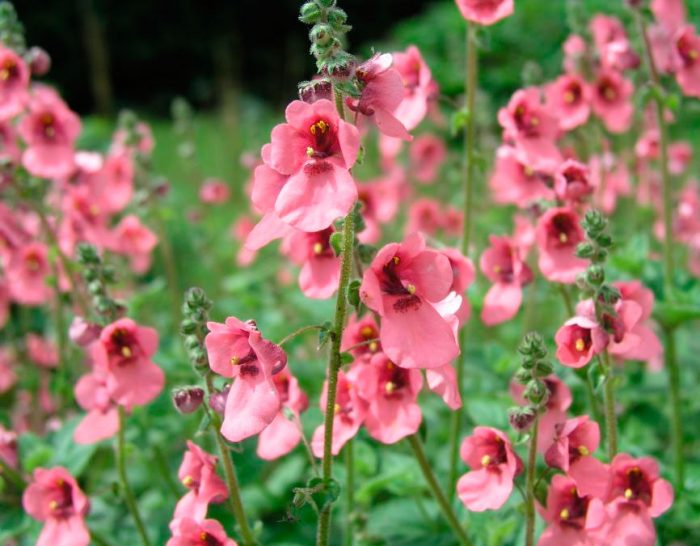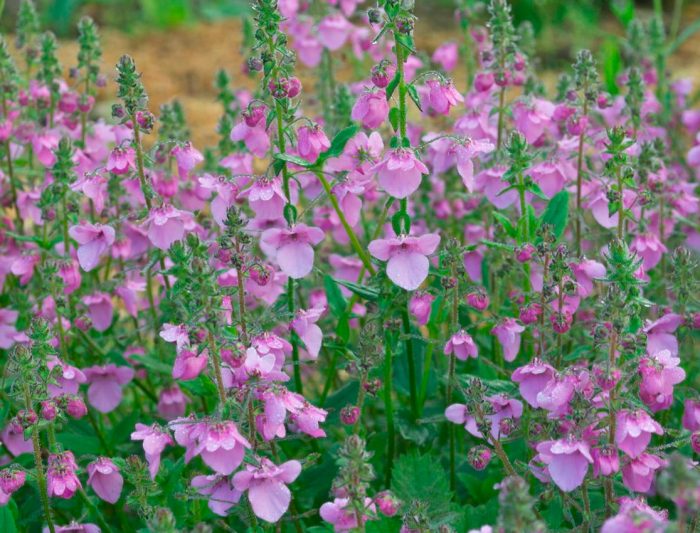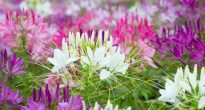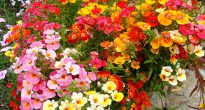The flowering plant Diascia belongs to the Noricidae family. This genus unites 68 species, which are represented by evergreen or semi-deciduous annuals and stolon perennials. This plant comes from South Africa, where it grows mainly in mountainous regions. This plant is quite popular among European gardeners. As a rule, perennial species prefer to grow in the mountains, and annuals - on arid plains. Diastia is cultivated in the open field as a curb plant or in a flower bed, and it can also be grown in containers or suspended structures.
Content
Brief description of cultivation
- Bloom... Flowering begins in the first days of June, and it ends with the first frosts.
- Landing... Seeds for seedlings are sown from the last days of February to the first - March, seedlings are transplanted into open soil - in the second half of May.
- Illumination... Needs lots of bright light.
- Priming... It should be slightly acidic, moist, not too nutritious, and include some sand.
- Watering... In the hot dry season, as well as after pruning in the summer, water often and abundantly. If it rains systematically in the summer, then the diastia is watered moderately, but they do it systematically.
- Fertilizer... The flower is fed regularly once every 4 weeks, for this, mineral fertilizer is used for flowering garden plants, while the dosage recommended by the manufacturer on the package must be halved.
- Pruning... When the bushes bloom for the first time, the stems are shortened by ½ part of their length.
- Reproduction... Cutting and seed method.
- Harmful insects... Slugs and snails.
- Diseases... Stem and root rot.
Features of diassage
Depending on the type, the shoots of the diastia can be creeping, erect or lodging.Under natural conditions, the height of the bush can reach 100 centimeters, but in culture they are not higher than 20–35 centimeters, while some of their shoots can stretch up to 0.6 m. Small sessile opposite leaf plates are painted green, their shape linear elliptical and serrated edge. Tubular flowers reach about 20 mm in diameter, their perianth is five-lobed: at the base of a pair of upper lobes there is a speck of yellow color, as well as spurs, 3 lower lobes are larger than the upper ones. During flowering, an apical racemose inflorescence is formed, consisting of flowers of pink, orange, white, purple, salmon or other color.
Bushes bloom in the first days of June, and flowering ends with the first frosts. Some species are highly resistant to frost and can withstand frosts up to minus 8 degrees, and sometimes up to minus 15 degrees. However, as a rule, in temperate climates, this flower is cultivated as an annual. When grown in a garden, this plant is most often planted in mixborders or in a rock garden in order to fill the voids between the bushes of large plants. Diastia can also be planted around the perimeter of courtyards and paved areas, as well as along garden paths. Such a plant looks great in both combined and single plantings.
Growing diastia from seeds
Sowing
As a rule, diastia from seeds is grown in seedlings. Sowing seeds for seedlings is carried out in the last days of February or the first - in March. For this, cassettes are used, which are filled with loose soil. In each of the cells you need to sow 3 seeds. Also, wide bowls are sometimes used for sowing. In this case, the seed is combined with sand (1: 5) and sowing is carried out. It is not necessary to cover the seeds from above with soil; instead, they are only slightly pressed into the pre-moistened substrate, and then the container is covered with glass (film) on top. A slightly acidic soil mixture with a low content of nutrients, which consists of sand and garden soil, is suitable for growing seedlings.
Growing seedlings
In order for seedlings to appear from seeds, the air temperature should be maintained at a level of 18 to 20 degrees. The first seedlings should appear after 10-15 days. Immediately after this, the containers with crops are transferred to a cool place (from 10 to 15 degrees). Remember that you must not allow the soil mixture to dry out in the container, but also make sure that the liquid in it does not stagnate in any way. It is recommended to water immature seedlings with a sprayer. When growing seedlings in a bowl, 15 days after the emergence of seedlings, it will need to be dived into individual cups.
During the growth of the seedlings, you will need to pinch the tops of its shoots, in which case the bushes will grow thicker and more spectacular. If seedlings of ampelous varieties are grown, then after it grows up and gets stronger, it is planted in pots or containers.
Planting diastography in open ground
What time to plant
Diastia seedlings are planted in the garden only after the ground warms up well, and the spring return frosts are left behind. As a rule, this time falls on the second half of May. However, before you start planting seedlings in open ground, it should be prepared. To do this, it is taken outside for a while every day, the duration of such sessions is gradually increased. After young plants are able to stay in the garden around the clock, they can be planted in open soil.
Landing rules
To grow a flower, you need to choose a well-lit area that has reliable protection from the wind. A suitable soil should be moist, slightly acidic and not very nutritious. It is recommended to add sand to it.Lowlands, where there is an accumulation of water, are not suitable for planting diastia. It will grow best near the southern wall of any building.
When planting between the bushes, you need to maintain a distance of about 15 centimeters. The planted flowers must be watered well.
Diastia care in the garden
Watering
Often and abundantly watering the diastion is necessary when it is hot outside, and even during the flowering period. But remember that it is impossible to allow liquid stagnation in the root system of flowers, as they react to this extremely negatively. When the bushes are watered, loosen the surface of the soil near the plants, and also pull out all the weeds.
Fertilizer
The plant is fed relatively rarely, only once every 30 days. To do this, use a fertilizer solution for flowering garden plants, while its concentration should be rather weak. If there are too many nutrients in the soil, then the bushes may not bloom at all. In addition, in too fertile soil, stretching of the shoots of the diastia is observed, due to which it loses its decorative effect.
Bloom
When the first wave of flowering is over, all the stems of the bushes should be shortened by ½ part. Then they need to be watered often and abundantly for 7 days in order for new shoots to grow. During one of the irrigations, it is recommended to use a complex fertilizer solution instead of water. After a very short time, the buds of the diastia will begin to appear again, and then the second wave of flowering will begin.
Diseases and pests
This plant is highly resistant to fungal diseases. However, if moisture stagnation is regularly observed in the soil, this can cause the development of stem and root rot. Creeping varieties suffer most from slugs and snails, in order to protect the stems of diastia from pests, they need to be lifted from the soil surface.
Diassage care at home
In room conditions, ampelous varieties of diastia are mainly cultivated, which are quite simple to care for. While the bushes are young, their shoots are straight, like those of bush varieties. However, when the height of the stems is about 30 centimeters, they will begin to sink down.
Landing
A good drainage layer is made at the bottom of the planting basket or pot, which can protect the root system of the flower from liquid stagnation in the substrate. A soil mixture for growing diastia should be chosen slightly acidic, loose and containing a small amount of nutrients. The optimal composition of the substrate: wet peat (or leafy soil), garden soil and perlite (or coarse sand), they are taken in equal proportions.
Watering and feeding
Watering should be abundant, but at the same time, moisture stagnation in the substrate should not be allowed. The plant is fed regularly once every 15–20 days, for this they use a liquid mineral fertilizer in a weak concentration. Organics for feeding diastia are not suitable. Do not overfeed the bush, as this weakens the shoots, becomes elongated and does not form flowers on them.
Pruning
All wilted buds, as well as faded stems, must be cut off in time, in this case the bush will actively grow young shoots. When the first wave of flowering comes to an end, it will be necessary to shorten all available shoots to 50 mm. Cut bushes are often and abundantly watered, and fertilizer is also applied to the substrate. After a very short time, young shoots grow in the bushes, on which bud formation is observed. Then the bush blooms again.
Seat selection
Diastia of ampelous varieties can decorate any room, as well as a terrace, loggia, balcony, veranda or other premises. For planting bushes, containers or balcony boxes are used, and for this you can use hanging structures, namely: baskets or pots. The flower looks great in large flowerpots.
Diseases and pests
When grown indoors, such a plant rarely gets sick.As a rule, problems with it arise only with an excess of nutrients in the soil mixture. That is why experts advise not to feed the flower at all in order to avoid overfeeding it.
Reproduction of diastia
How to grow diastia from seeds was described above. Also, cuttings can be used to propagate this plant. Rooting of stem cuttings is carried out in the last summer weeks. To do this, they are planted in a moist soil mixture and kept at room temperature. In autumn, if desired, the plant can be propagated by root cuttings. In spring, as planting material, you can use the shoots that remained after pruning the overwintered bush. Cuttings should be about 8 centimeters long. When the cuttings take root and begin to grow actively, pinching the tops of the stems should be carried out to stimulate tillering.


Watch this video on YouTube
Wintering of perennial diastia
In regions with a temperate climate, perennial diastia in the garden is cultivated as an annual. But if desired, in the autumn, the bush can be dug out and planted in a pot, using a loose soil mixture for this. In winter, the bush should be in a well-lit room that is not heated, while it should not be colder than 5 degrees. In winter, diastia is watered very rarely and with a small amount of water.
In early spring, the soil in the pot is replaced with fresh soil, then the bush is transferred to a warm place and its stems are trimmed. As the shoots grow back, you need to pinch them, thanks to this the bush will be thicker and more effective. When about 15 days remain before transplanting the plant into the garden, it should be hardened. You can plant it in open ground immediately after the return frosts are left behind.
Types and varieties of diastia with photos and names
Diastia vigilant (Diascia vigilis)
In this plant, the length of the hanging stems can reach 0.5 m. The flowers are pink.
Felt diastia (Diascia fetcaniensis)
Rounded relatively small leaf plates are painted in a pale green hue. On their surface there is a dense pubescence, consisting of soft hairs. In length, the peduncles reach about 25 centimeters, flowers of a dark pink color are formed on them, on the surface of which there are many red strokes. In diameter, the flowers reach about 20 mm, due to the presence of a spur directed forward, they have a very effective and unusual appearance. This species is not afraid of frosts up to minus 15 degrees.
Diascia rigescens
In the southern and western parts of England, this species is cultivated as a perennial, but in Holland it freezes out during the winter. The stems are about half a meter long. The bulk of the foliage is located at the base of the bush, in autumn it turns brownish-red. Dark pink flowers reach about 20 mm in diameter.
Diastia bearded (Diascia barberae)
In temperate climates, this species is an annual, which has a branchy bush, reaching a height of about 0.3 m. Flowering begins after the length of the shoots is 7-10 centimeters. Glossy small leaf plates, painted dark green, are mainly located at the base of the bush. On the peduncle, many flowers are formed, reaching about 15 mm in diameter, which can be painted in various shades of pink, they have a yellow speck in the throat. The best varieties:
- Pink queen... The pinkish flowers are milky.
- Apricot queen... Bushes are decorated with orange inflorescences.
- Salmon queen... The flowers are pinkish-orange.
- Basya... This annual blooms twice in one season. Velvety drooping flowers of deep pink color reach about 20 mm in diameter.
- Ruby Field... Inflorescences are dark pink.
Diastia Blackthorn Epricot
In this hybrid, the shoots are lodging, and the spur flowers are large, they are painted in warm shades of pink: from salmon pink to light apricot.
Diaztia Elegance
How this hybrid garden form came about, experts do not know. Such a plant is distinguished by its unpretentiousness and power. Its drooping shoots are adorned with lush, glossy foliage of a dark green hue. The pinkish flowers have a dark speck in the throat.
Jack Elliot
This garden variety of unexplained origin can reach a height of about 0.4 m. On the stems, lush glossy foliage of a rich green color grows. Cherry-red or dark pink flowers reach at least 2.5 cm across. They have a speck of violet hue in the throat, and a yellow depression is clearly visible above it.
Laylek Bell
This garden form is very popular with gardeners and is often grown for sale. The bush has a height of about 0.3 m, while the length of the foliage is about 40 mm. Not very long lush peduncles consist of many small flowers in diameter reaching up to 1.5 cm, their corolla is flattened, and there is a speck of yellow tint in the throat. This shape is great for filling the space between large plants, as well as for composing compositions in containers.


Watch this video on YouTube


